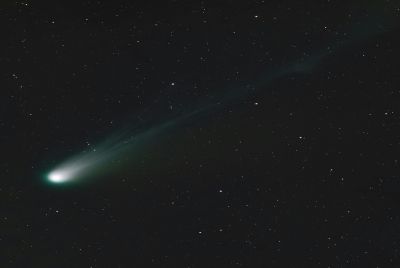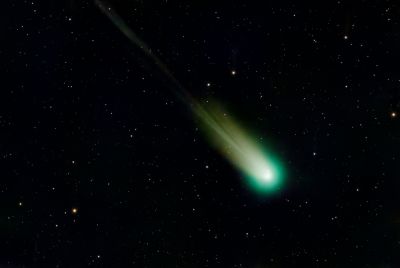3I/ATLAS Defies Odds: Astronomers Detect 2.85-Million-Kilometer Jets from Interstellar Enigma
New observations reveal colossal jets from 3I/ATLAS, raising questions about interstellar comet behaviour

Astronomers have captured a breathtaking image of interstellar comet 3I/ATLAS releasing jets of gas and dust stretching an astonishing 2.85 million kilometres — more than three times the diameter of the Sun.
The rare phenomenon has challenged long-standing models of cometary physics and reignited debate about whether the object's behaviour can be explained entirely by natural processes.
A Jet Phenomenon Beyond Expectation
Composite images captured between 05:08 and 05:22 UT on 9 November 2025 reveal 3I/ATLAS's dramatic emissions. The sequence, built from five three-minute exposures using twin telescopes, shows twin anti-tail jets and a sun-facing plume that extends across vast distances of space. In the lower-left corner of the frame, the Sun appears as a small reference point — emphasising the sheer scale of the comet's activity.
Researchers say the pattern and power of the jets suggest a nucleus larger and more active than earlier estimates indicated. The comet's retrograde orbit and extreme outgassing are unlike anything previously recorded in interstellar visitors.
Harvard Astrophysicist Raises Questions

Harvard astrophysicist Professor Avi Loeb noted that the jets' energy output and geometry are 'statistically improbable for a typical natural object'. While he stopped short of suggesting an artificial origin, Loeb's remarks have reignited scientific debate about what powers such unprecedented ejections.
'The combination of a giant core, sunward jets, and dual anti-tails has never been observed together before,' Loeb explained in an interview published by the Harvard Galileo Project. His comments have prompted further examination of whether 3I/ATLAS may represent a new class of interstellar bodies rather than a conventional comet.
Unprecedented Jet Structures
Follow-up analysis by independent observatories confirmed the two opposing anti-tail structures, which are oriented directly toward the Sun. This alignment defies conventional models of solar wind interaction, which typically disperse such material away from the Sun's direction. Scientists believe these features could result from unique internal layering or magnetic properties that are yet to be understood.
Teams are now studying 3I/ATLAS's chemical composition, thermal profile and rotational velocity to model how interstellar ice and metals behave under solar heating.
What Sets 3I/ATLAS Apart
3I/ATLAS is only the third verified interstellar object after ʻOumuamua (2017) and 2I/Borisov (2019). Unlike its predecessors, it shows sustained activity — ejecting material as it moves through the Solar System.
According to NASA's Jet Propulsion Laboratory, its hyperbolic orbit confirms it entered from beyond the Solar System and will never return. Its closest approach to Earth will occur at roughly 1.8 astronomical units, or about 270 million kilometres, posing no impact risk.
The comet's retrograde motion and immense jets have made it a key case study for scientists exploring how foreign cosmic materials respond to solar radiation.
Implications for Future Research
The discovery of such extensive jets on an interstellar object opens new avenues for research into cometary evolution, solar system formation and interstellar chemistry. It also raises questions about the frequency and nature of interstellar visitors.
If 3I/ATLAS continues to exhibit such anomalous behaviour, it may prompt revisions to existing models of mass ejection, cometary structure and solar interaction. The comet's journey presents a rare opportunity to observe how materials from beyond our solar system behave under the Sun's influence.
Astronomers are expected to continue monitoring 3I/ATLAS as it exits the solar system over the coming decades. Its legacy may lie not only in its dramatic jets but in the questions it leaves behind.
3I/ATLAS has defied expectations with its 2.85-million-kilometre jets, prompting renewed interest in interstellar phenomena. As scientists analyse its behaviour, the comet stands as a reminder of the vast unknowns that still surround our understanding of the cosmos.
© Copyright IBTimes 2025. All rights reserved.




















